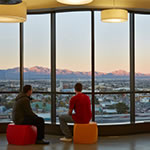The phrase “landing the spaceship” is an architectural cliché, most often used to describe the attention-grabbing projects of architects like Frank Gehry and Zaha Hadid. In the case of the new headquarters for online shoe retailer Zappos, which took over the old Las Vegas city hall in 2013, the spaceship landed a long time ago.
Originally built in 1973, the modernist campus, which features a central rotunda and an 11-story, semicircular concrete tower, sat vacant after the city moved into its new home in 2012. Surrounded by vacant lots and convenience stores, the building is fairly conspicuous. Yet the company has embraced the “spaceship’s” quirks and even added a few of its own: until recently, a bedazzled UFO sat parked in the center of the rotunda, a piece of Burning Man art that Zappos turned into a cozy conference room.

Photo: Bruce Damonte

Photo: Nicholas Swan

Photo: Nicholas Swan

Photo: Nicholas Swan
Renovating a 40-year-old, 300,000-square-foot structure is an unusual choice for an Internet company that was sold to Amazon for more than $1 billion, but Brad Tomm, the company’s senior manager of campus operations and sustainability, says the alternative option was building a new headquarters on virgin desert land. The potential environmental impact was enormous, he says. Instead, Zappos saved the city hall building from demolition and simultaneously prevented the development of a greenfield site outside the city.

Brad Tomm is the senior manager of campus operations and sustainability at Zappos.
“It’s such a lower-impact project if you renovate a building,” Tomm says. “We proved that you can take a building from the ’70s that’s got its quirks and challenges and turn it into a LEED Gold building.”
Respected San Francisco design firm KMD Architects led the renovation, working with Las Vegas firm Carpenter Sellers Del Gatto. Major investments were made to create a headquarters that uses only three quarters of the energy of a comparable office building and less than half the water. The biggest energy saver was an upgrade to the central plant. “That’s the real heart of a building, and the heart has to be healthy,” Tomm says.
The team replaced the chillers, boilers, and cooling towers. Although the campus retains its single-pane windows—a cost-benefit analysis showed a retrofit to be too costly—the impact was less than the team expected. “Our energy model still shows a 25-percent reduction in energy compared to the baseline—even keeping those windows,” Tomm says. “So we’re still kicking ass.”

Photo: Bruce Damonte

Photo: Nicholas Swan

Photo: Nicholas Swan
The downtown location serves another purpose. By moving into the city’s economically depressed downtown, CEO Tony Hsieh—who has become known for his pursuit of the “three C’s”: collisions, co-learning, and connectedness—hopes to revitalize the area, and he intentionally limited on-site amenities in order to tacitly encourage employees to venture off campus. He drew inspiration from the porosity of the New York University campus.
“It’s working,” says Tomm, who reports that many of Zappos’s 1,500 employees walk or ride their bikes to work and venture off site for lunch and happy hour.
It’s a lesson in the value of limitations. Take the existing sky bridge, which once connected a parking garage to the existing tower. It may have been convenient, but convenience is not one of the three C’s. The company sealed it off, forcing employees and visitors to enter through the main entrance, and turned the bridge into a “sky park,” outfitted with hammocks, artificial turf, and a bocce ball court.
It is easy to see why Bloomberg named the Zappos headquarters one of the most impressive offices in the world, but Tomm and his team have even bigger plans in the works, including the design of a second Zappos building across the street, currently in the planning phase. He says without the constraints of an existing building, he expects this next project to be even higher performing.
“We definitely don’t think we’re the leader in sustainability,” Tomm admits. “We really admire companies that have been doing this for 15 or 20 years, and we know we’re racing very quickly to catch up to the bar. But once we’re at the bar, we have plans to surpass it.”
—
 MORE ON LAS VEGAS
MORE ON LAS VEGAS
“Although we project a carefree, party image, southern Nevada is quite serious about our resource plan.”
– Doug Bennett, Conservation Manager, Southern Nevada Water Authority

“The biggest change Las Vegas has undergone is having to learn how to handle a crushing blow and get up and build yourself into a better community. And you can see it. It builds resolve.”
– Cindy Ortega, Chief Sustainability Officer, MGM International

